(Written by William)
I’ve always had a soft spot for arcade machines. I even built my own claw machine that you’d find at an arcade. So, hearing that the #10323 LEGO PAC-MAN Arcade machine was going to be a real set, I got excited. Then I saw the price and felt less excited. In fact, I didn’t pay much attention to the set anymore. But I did keep it in mind for when it came time to ask for sets to review, and I was completely blown away by just how much this thing does! But I’m going to try to remain neutral in this review.
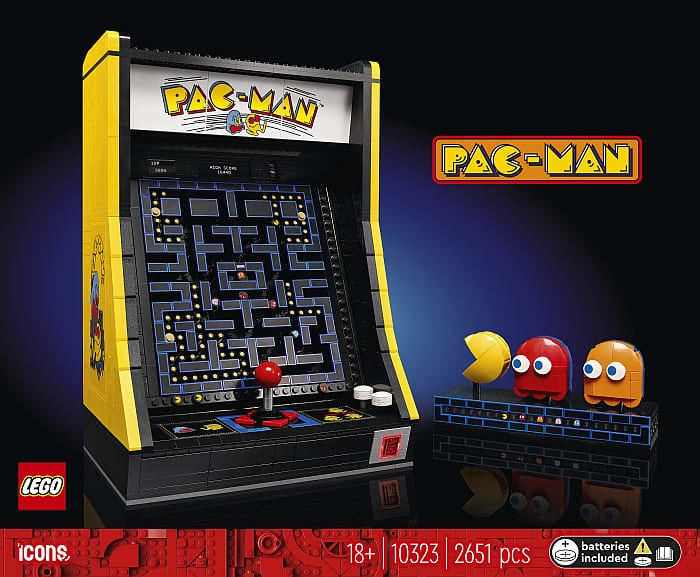
As far as play features, you get a detachable top display that has a cool mechanism. You also get a button that lights up the 25-cent display. Then, there is a gear you can move to change the display. In addition, the joystick has an interesting range of movement and feels nice in the hand. And good gravy, the characters on the screen move! What magic voodoo is this?
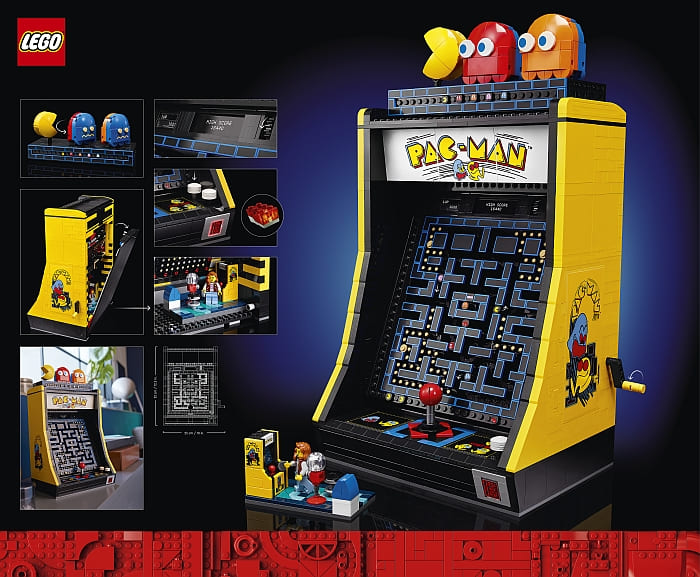
This set is LEGO’s offering some of the most advanced building experiences all wrapped up in pixelated nostalgia. I honestly feel bad that I walked away from this set after seeing the price tag. Because having built it, the cost totally makes sense. So, let’s dig in and see what techniques we can learn to level up our own building game!
LEGO PAC-MAN ARCADE – TAB INTERLOCKING
The sides of the arcade cabinet are two bricks thick and they extend fairly high. This means they will need to be reinforced in some way to stay structurally sound as well as hold the weight of the other parts of the model. To achieve this, LEGO designers used some techniques I’ve seen before; long pieces used sideways to add additional stability. The stickered tiles on the sides serve this purpose being built on a series of bracket faces. They also have a couple of long struts on the opposite wall to lend more stability. However, there is an issue.
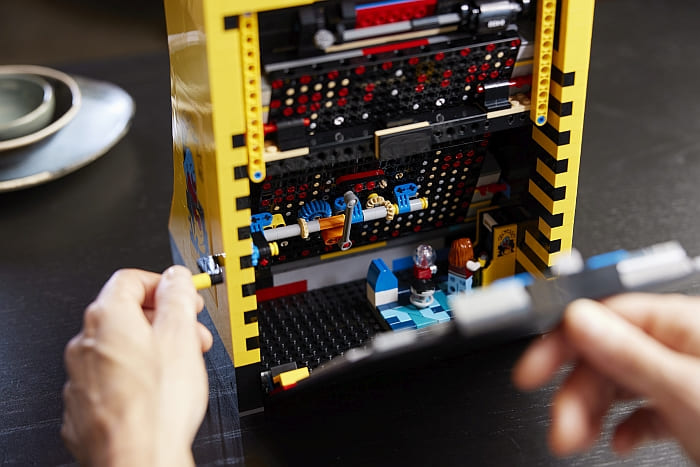
The front of the model needs to accommodate a lot of slopes to have the right shape. Additionally, it is fairly exposed, meaning you can see the black interior wall and the yellow exterior wall quite plainly. This means there is not much room to use standard methods for reinforcing a wall. So, what do LEGO designers do? They use a technique I’ve never seen before. In fact, it made me pause just trying to figure out why they were building things in the manner they were.

You see, every now and then, either the yellow wall or the black wall would have a bracket that extended into the other wall. The odd thing is, it wouldn’t attach to anything. It would just fill up a hole you build for it. Around the third instance up the wall, I finally understood what was going on. Each of these brackets acts as a sort of tab that is being slotted into the other half of the wall.
This simple yet effective bit of geometry added a surprising amount of stability to the wall. Building up a wall this high creates a lot of weak points. This is especially true if you can’t interlock the wall sections. However, the color is also important. This solution allowed the walls to quasi-connect to each other, thus gaining much of the benefits of simply interlocking the two sides.
The upside of this technique is that you gain stability without losing looks. The downside is you need to really be on point with how much space a bracket takes. Also, this will require more pieces and more thought to build in an effective way. However, if mastered it’s a nice trick to have in your toolbox.
LEGO PAC-MAN ARCADE – CHAINS & BELTS
This set does have a number of great parts. However, one of the elements that is most exciting is a new chain link. This link has a bar sticking out of one side. This now allows us to mount something onto a chain, thus changing one of its functions from a drive chain to a conveyor belt.
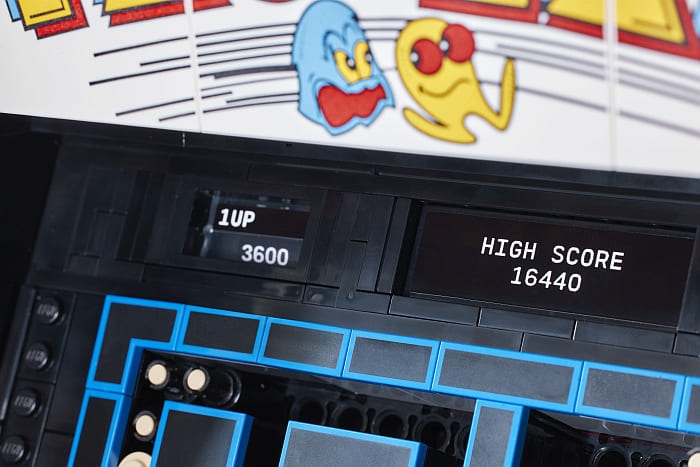
Belts can certainly act as chains. You’ve more than likely heard the term drive belt. However, belts aren’t really a thing in LEGO. The closest we have had are treads and they’re often limited to straight lines.
This bar on a single side of a link gives it the ability to turn corners. And that is exactly what’s on display on the game screen. LEGO designers start off simply with a few gears to hold the chain. But then they show the new potential by adding wheel hubs and rounded ball-joints to press against the chain in different spots to showcase the more precise movements you can now get from a mechanized display.
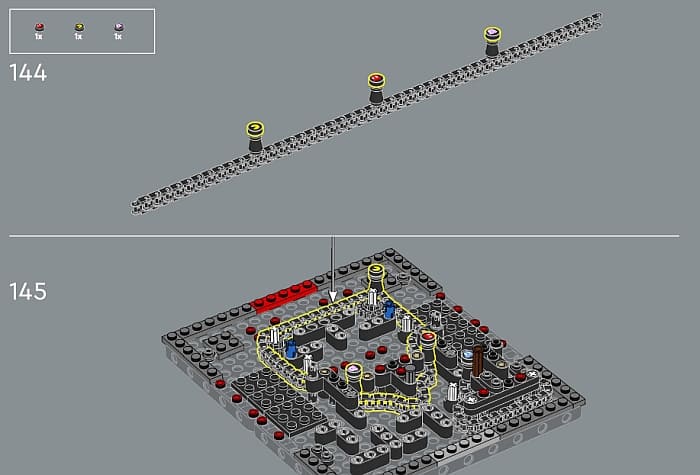
But wait, there’s more! Not only does this bar give us the ability to change a chain into a conveyor belt, but it also allows us to turn it into a timing belt. This functionality is not displayed in this model, but it is easy to imagine.
Let’s say you want something to happen every five turns of the crank or maybe you want something to act a little sporadically. If your mechanism triggers, for example, when the bar from this new link hits it, you can pretty much program the time of every action just by placing this new piece anywhere on your chain. I honestly can’t wait to see what LEGO fans do with this technique.
LEGO PAC-MAN ARCADE – REHEARSAL BLACKS
It’s not often that LEGO instructions call out a building technique specifically. And because it happens in this set, it made me really take notice. You see, one of the ways the game screen looks as good as it does is because all the mechanisms just blend into the background because they are black. I had to go back to my theater days to find a good outside example of how this principle works.
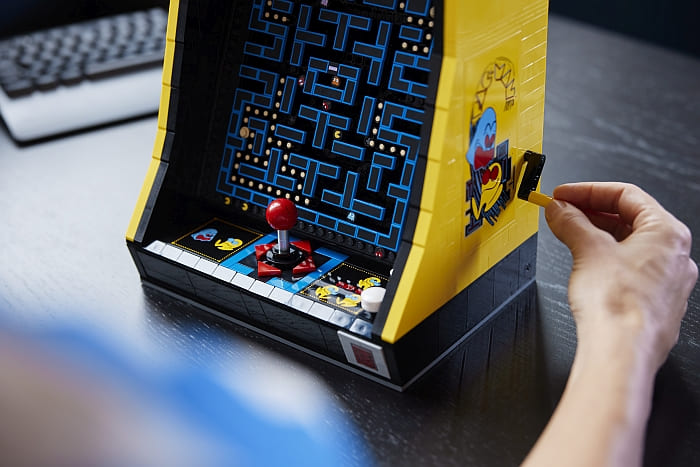
When actors go into rehearsal for a play, they are told to wear rehearsal blacks. Likewise, a stagehand or crew member for any performance will always be wearing black or as dark of clothes as they can get. Why is that?
The idea is that you want to minimize all the distractions so the important elements shine through. For the actors in rehearsal, they need to focus on their acting and shouldn’t get distracted by their costumes. For the stagehands, it is so they can blend into the background and become as invisible as possible. All of these efforts are to help what’s called the suspension of disbelief.
Let’s face it, you know that’s not a real dragon on stage, nor is it the 1940’s. But the audience is willing to suspend their disbelief to imagine this is the case. They want to be transported and entertained. Likewise, you want to imagine PAC-MAN is electronically moving around your LEGO-built screen setting a high score.
So what’s involved in achieving this with LEGO? This is both one of the easiest and most piece-intensive techniques there is. As for the parts you use, keep the ones you don’t want to be noticed as black. The hard part is building your stage. You must control how the object is viewed as well as the background.
LEGO doesn’t normally do this, but the designers built a backing for this model. That’s because they can’t have light show through the mechanism thus ruining everything you’re trying to hide.
Other colors can also be used to achieve this effect. The only reason I wouldn’t recommend it is because it would require the right lighting. Unfortunately, lighting is still an area in which LEGO is not well-versed. So, in the meantime, I suggest sticking with black and keeping to the shadows!
LEGO PAC-MAN ARCADE – FINAL THOUGHTS
From start to finish, this was a novel building experience. The large scale of the model offered new challenges for LEGO designers to overcome while providing the space to showcase something new. And the end result is downright magical when you see it work.
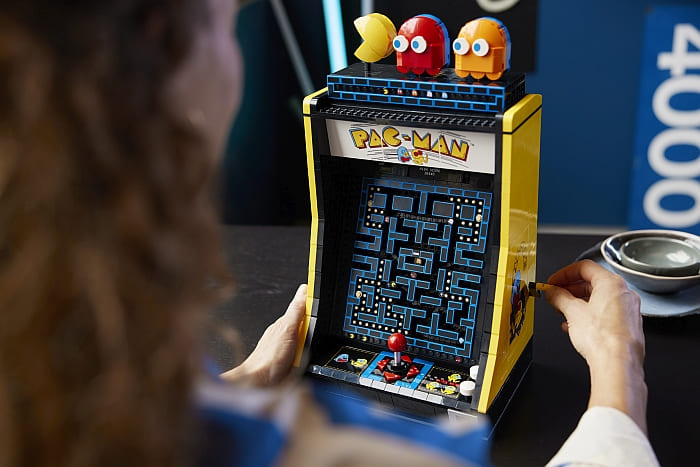
As an added bonus, this set is a fantastic parts pack. There are plenty of great new elements like the rounded 1×3 plate and a couple of giant LEGO Technic pin boards (these are the large 19×11 flat surfaces the entire game screen is mounted upon). And I can definitely see LEGO fans getting a lot of use out of the printed tiles that help make up the walls of the maze.
I think the only downside is that this is a rather demanding model to put together. Even though it is broken up into 14 bagged steps, you’ll want an avid builder to put this together. I’m just not sure avid LEGO builders are diehard PAC-MAN fans. Plus, the price would make anyone pause. However, if you are up for the building challenge the #10323 LEGO PAC-MAN Arcade is well worth the price. In the video below, I talk about the set in a bit more detail and also show you the play-functions.
If you like the #10323 LEGO PAC-MAN Arcade machine and think about getting it, it is available at the LEGO Icons section of the Online LEGO Shop.
What do you think? How do you like the LEGO PAC-MAN Arcade? Do you have the set already? Or are you planning to get it? And what do you think of the building techniques we discussed? Feel free to share your thoughts and own reviews in the comment section below!
And you might also like to check out the following related posts:












This Is like the most mind blowing set of all time. This and the NES. But I think this is even better. I know you build both of them. From the two, which one do you like better? And why?
Ooo, I do like both for different reasons.
I think I still like the NES set better. The reason being is that I have a much stronger nestalgia connection to it.
But with that said, the Pac-Man Arcade really is more advanced building and mechanisms.
So, my personal fav is NES, but I do think the Pac-Man Arcade is better from an objectively building stand point.
Wow, this is even cooler than I thought; I love kinetic LEGO sculptures, and this is a good example of what can be done with just gears and chains!
Yeah, this model did not prepare me for its kinnetic aspects.
It really does set it above and beyond your average kinnetic model in that it makes sure to hide so much of its working elements. And does it in plain sight. Very cool!
This is a fantastic set. The pinnacle of LEGO building! Love everything about it. Well, except for the stickers.
Yeah, that’s why I try to make sure to point out the times when they use stickers.
It’s something LEGO has been trying to avoid for the adult oriented sets. The exception is when the real life version had a sticker.
I think in the case of game cabinets they did have to apply stickers. At least for certain machines.
Incredible set! I have never seen anything like it. Not even from master builders.
There’s actually a reason for that.
Working mechanisms tend to take a lot of time to get right. LEGO will often build robots to continuously test the working mechanisms in their sets. For things like LEGO Masters, there is just not enough time for the builders to work things out so you will probably never really see someone making something like this.
I will say, this kind of work reminds me of stuff JKBrickworks builds. I suggest trying to find their Youtube channel. It’s just one amazing LEGO creation after another.
The chain link could be useful for ght
Sorry, my comment went thru too early. I was saying that the new chain link piece could be great for ball contraptions.
Any other thing you guys could think of using it for?
So, in the Detective’s Office modular building they used chain link treads to help build the round shape of the water tower. Given the fact these are also links but with bars, it also opens up possible rounded decorative elements.
I also wouldn’t be surprised to see someone using it to help shape a fancy looking roof as well. Look at any of the larger Ninjago sets, they will build a roof out of dang near anything that has a little flexability to it.